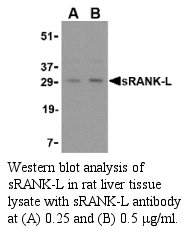Anti-Human RANKL
Anti-Human RANKL
Product No.: R1242
- -
- -
Target Receptor Activator of NF-κB Ligand Product Type Polyclonal Antibody Alternate Names CD254, TRANCE, hRANKL2, sOdf, TNF-Related Activation-Induced Cytokine [TRANCE], Osteoprotegrin Ligand [OPGL], Osteoclast Differentiation Factor [ODF], TNFSF11 Applications WB |
Data
- -
- -
Antibody DetailsProduct DetailsReactive Species Human Host Species Rabbit Immunogen PN:R1243 Product Concentration 0.5 mg/ml Formulation This polyclonal antibody is formulated in phosphate buffered saline (PBS) pH 7.4 containing 0.02% sodium azide as a preservative. Storage and Handling This polyclonal antibody is stable for at least one week when stored at 2-8°C. For long term storage, aliquot in working volumes without diluting and store at –20°C in a manual defrost freezer. Avoid Repeated Freeze Thaw Cycles. Country of Origin USA Shipping Next Day Ambient RRIDAB_2831686 Each investigator should determine their own optimal working dilution for specific applications. See directions on lot specific datasheets, as information may periodically change. DescriptionDescriptionSpecificity Rabbit Anti-Human soluble Receptor Activator of NF-κB Ligand (sRANK Ligand) recognizes Human, Mouse and Rat sRANK Ligand. This polyclonal antibody was purified using affinity chromatography. Background RANKL (Receptor Activator for Nuclear Factor κ B Ligand), also known as TNF-related activation-induced cytokine (TRANCE), osteoprotegerin ligand (OPGL), and ODF (osteoclast differentiation factor), is a member of the tumor necrosis factor family cytokine.1 RANKL is essential for osteoclast formation, activation, and survival.2 RANKL through interaction with its receptor RANK can modulate matrix degradation and inflammation.3 RANKL and RANK have essential roles in lymph node formation, establishment of the thymic microenvironment, and development of a lactating mammary gland during pregnancy. Consequently, novel drugs specifically targeting RANK, RANKL, and their signaling pathways in osteoclasts are expected to revolutionize the treatment of various ailments associated with bone loss, such as arthritis, periodontal disease, cancer metastases, and osteoporosis.4 References & Citations1. Takayanagi, H. et al. (2003) Arthritis Res Ther. 5: 20 2. Kostenuik, PJ. et al. (2005) Endocrinology 146: 3235 3. Holven, KB. et al. (2009) Stroke 40: 241 4. Penninger, JM. et al. (2008) Ann N Y Acad Sci. 1143: 123 Technical ProtocolsCertificate of Analysis |
Related Products
- -
- -
Prod No. | Description |
|---|---|
R1242 | |
R1352 | |
I-1045 | |
R1355 | |
R1356 |



